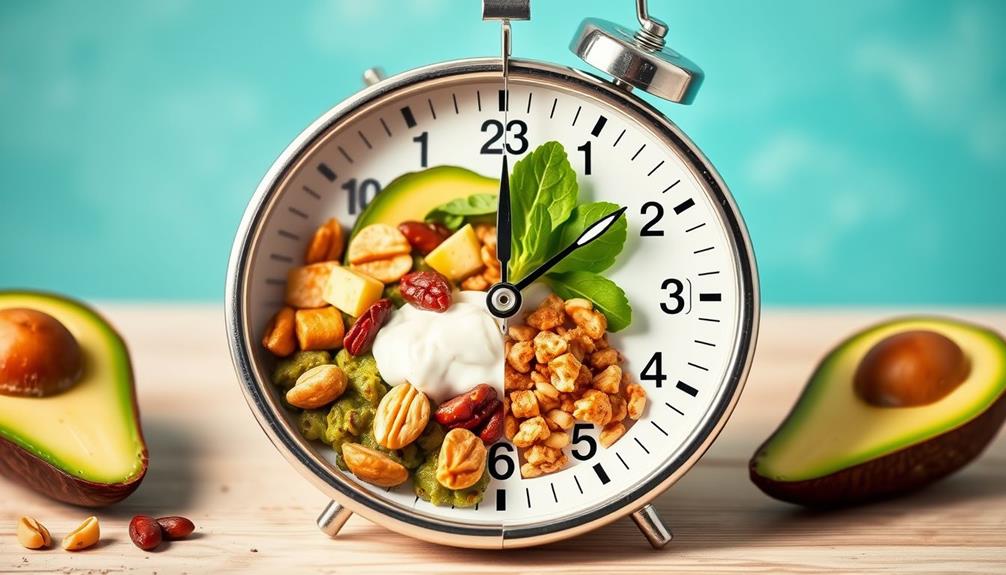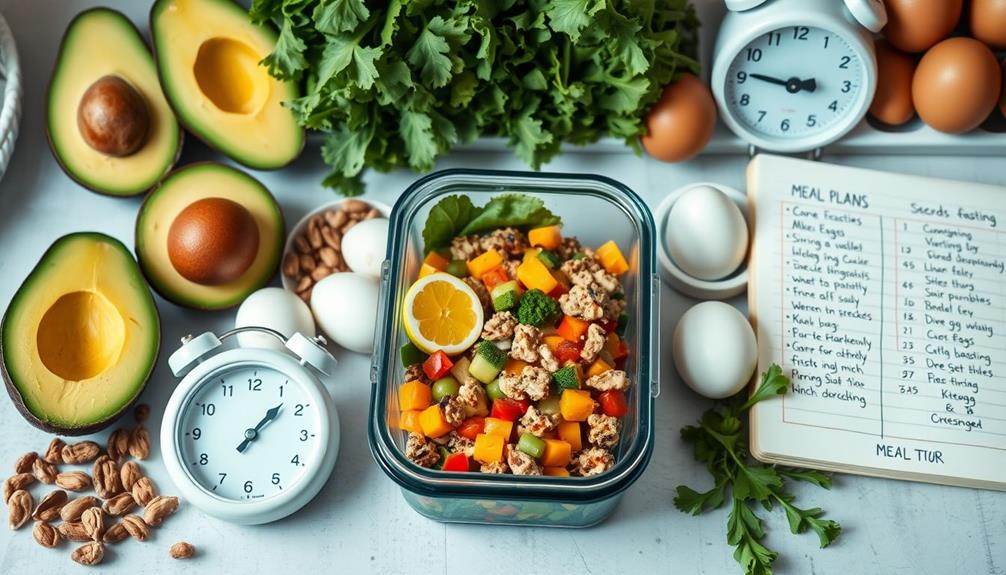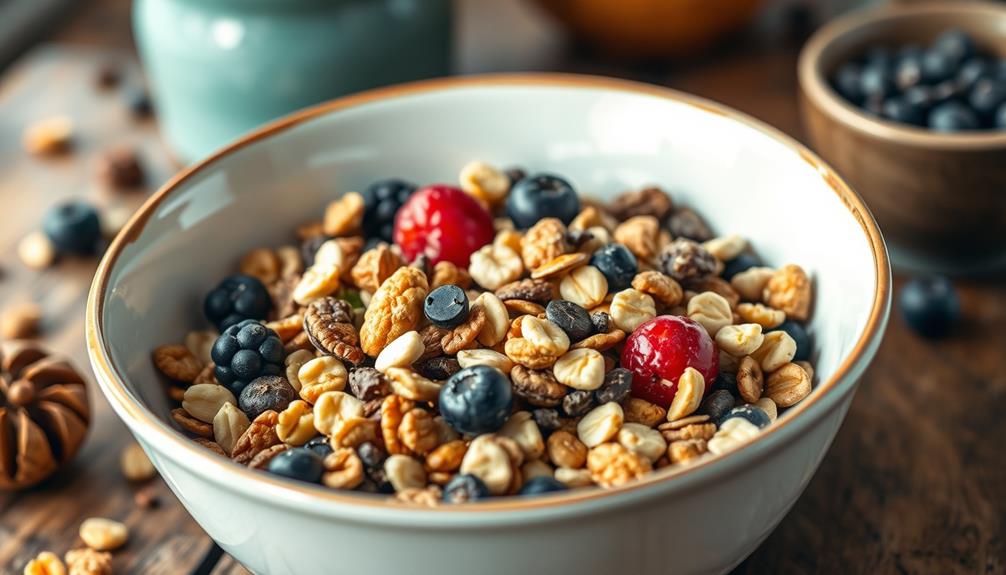To start the keto diet and intermittent fasting, begin by cutting carbs to 20-50 grams per day while focusing on high-fat foods like avocados and olive oil. Track your macronutrients to maintain the right balance of fats, proteins, and carbs. After two weeks, introduce intermittent fasting by starting with a 12-hour fasting window, gradually extending it to 16 hours. Stay hydrated with non-caloric beverages during the fast. Monitor your body's response and adjust as needed for comfort. There's plenty more to explore about meal plans and tips to guarantee you succeed in this journey.
Key Takeaways
- Limit carbohydrate intake to 20-50 grams daily and focus on high-fat foods like avocados and olive oil.
- Start with a ketogenic diet for two weeks before introducing intermittent fasting for easier adaptation.
- Gradually implement a 16:8 fasting schedule, beginning with a 12-hour fasting window.
- Monitor macronutrient ratios and hydration, ensuring adequate intake of electrolytes.
- Consult a healthcare provider before starting, especially if you have existing health conditions.
Basics of the Keto Diet

The ketogenic diet, often referred to as the keto diet, is a low-carb, high-fat eating plan designed to shift your body into a state of ketosis, where it burns fat for fuel instead of carbohydrates. To achieve this, you'll want to follow a specific macronutrient ratio, typically comprising about 70-80% fats, 15-25% protein, and only 5-10% carbohydrates. This means limiting your carb intake to around 20-50 grams per day.
As you cut back on carbohydrates, your body enters ketosis, promoting weight loss by using fat for energy instead of glucose. Juice diets may lead to nutrient deficiencies if not balanced, which is an important consideration when planning your meals on keto.
The diet originally emerged in the 1920s to help manage epilepsy, but it has since gained traction for its potential benefits in weight loss and improved metabolic health.
When planning your meals, focus on healthy eating by choosing foods like avocados, olive oil, nuts, seeds, fatty fish, and grass-fed meat. However, avoid most grains, sugars, and starchy vegetables.
While initial weight loss may be rapid due to water loss from glycogen depletion, long-term success requires careful meal plans to prevent nutritional deficiencies.
Understanding Intermittent Fasting

Intermittent fasting (IF) offers a flexible approach to eating that can fit seamlessly into your lifestyle. This eating pattern cycles between periods of eating and fasting, with popular methods like the 16:8 schedule, which involves 16 hours of fasting followed by an 8-hour eating window.
Research shows that fasting for weight loss can be effective, promoting significant fat loss while enhancing insulin sensitivity and reducing inflammation. Additionally, incorporating a well-structured budget for meal planning can help manage expenses associated with a keto diet.
During your fasting window, you're encouraged to consume only non-caloric beverages like water, tea, or black coffee. This practice not only helps maintain hydration but also supports the health benefits of fasting, such as improved metabolic health.
Although IF can be safe and effective for many, it's essential to consult a healthcare provider, especially if you're pregnant, breastfeeding, or have certain medical conditions.
Incorporating fasting and keto can further amplify your results, as both aim to optimize your body's fat-burning capabilities. While calorie restriction is a key element, understanding how to balance your eating pattern with IF can lead to sustainable long-term changes.
Benefits of Combining Both

Regularly combining the ketogenic diet with intermittent fasting can greatly enhance your weight loss efforts and overall health. This powerful duo promotes fat burning by encouraging your body to efficiently use fat for energy, leading to significant reductions in body fat and waist circumference. You'll also notice improved insulin sensitivity, which is essential for blood sugar control and can lower the risk of Type 2 diabetes.
Here's a quick overview of the benefits:
| Benefit | Description |
|---|---|
| Appetite Control | High-fat foods help you feel full during fasting. |
| Energy Levels | Increased ketone production boosts mental clarity. |
| Weight Management | Enhanced fat loss and reduced calorie intake. |
| Simplified Meal Planning | Fewer meals mean focused, nutrient-dense eating. |
Steps to Start Keto

Starting the keto diet can feel overwhelming, but breaking it down into manageable steps makes it easier. Begin by drastically reducing your carbohydrate intake to 20-50 grams of net carbs per day. This limits your carbs while increasing fat consumption to about 70-80% of your total daily calories, helping you enter ketosis.
Focus on incorporating high-fat foods like avocados, olive oil, fatty fish, nuts, and seeds, while steering clear of grains, sugars, and starchy vegetables. Additionally, incorporating effective strategies for weight loss can help support your journey, guaranteeing that your dietary changes are sustainable and beneficial for your overall health.
To guarantee you're on track, use apps or food journals to track macronutrients, maintaining the right ratios of fats, proteins, and carbohydrates. Staying hydrated is vital, so consider supplementing with electrolytes—particularly sodium, potassium, and magnesium—to help alleviate potential side effects like the "keto flu" during the initial adaptation phase.
Once you've maintained the keto diet for at least two weeks, you can gradually introduce intermittent fasting. This approach allows your body to adapt to fat fuel, ultimately enhancing the health benefits of both dietary methods.
Following these steps will set you on the path to successfully starting your keto journey.
How to Implement Intermittent Fasting

Implementing intermittent fasting can greatly enhance your keto journey. Start by establishing an intermittent fasting schedule, beginning with a 12-hour fasting window. This allows your body to adjust before gradually increasing to a 16-hour fast, a common approach in the 16:8 protocol.
During fasting periods, stick to no-calorie beverages like water, black coffee, or herbal tea to stay hydrated and help curb hunger. It's also crucial to be mindful of your overall health, as certain health conditions can affect your fasting experience, similar to how cold medications have side effects.
When the time comes to eat, focus on nutrient-dense, high-fat diet foods. Incorporate avocados, nuts, and grass-fed meats into your meal plan to guarantee you're getting enough energy and nutrients.
It's important to balance your meals with healthy fats, proteins, and low-carb vegetables to support your fasting routine effectively.
As you progress, monitor your body's response to the fasting durations and adjust as needed. If you experience discomfort or have existing health conditions, consult a healthcare professional for guidance.
With a thoughtful approach, intermittent fasting can complement your keto efforts, helping you achieve your health goals while enjoying delicious, satisfying meals.
Sample Meal Plan

To make your keto diet and intermittent fasting journey easier, let's look at a sample meal plan.
You'll want to focus on nutrient-dense foods that align with the high-fat, low-carb approach, ensuring each meal keeps you satisfied.
Understanding different dietary approaches can greatly enhance your experience, similar to how various brewing methods affect the flavor profile of coffee brewing methods affect caffeine content.
Daily Meal Ideas
Creating a daily meal plan for your keto diet and intermittent fasting schedule can simplify your journey toward healthier eating. For a 16:8 intermittent fasting approach, start your day with a high-fat breakfast featuring avocado and eggs cooked in olive oil. This meal helps you kick off your eating window with nutrient-dense foods that fuel your body.
Additionally, incorporating essential oils for wellness such as peppermint or lavender can enhance your overall health during this change.
For lunch, consider a grilled chicken salad drizzled with olive oil dressing. This option not only meets your daily protein intake but also incorporates healthy fats to maintain satiety throughout the day.
As you move through your eating window, don't forget to enjoy snacks like cheese cubes, nuts, or celery with cream cheese to keep hunger at bay.
Dinner can be a delicious ribeye steak paired with steamed broccoli and a side of garlic butter, ensuring you're consuming quality meats and veggies.
Throughout your fasting period, hydrate with water, herbal teas, or black coffee, avoiding any caloric beverages that could disrupt your fasting state.
Nutrient-Dense Food Choices
When planning your keto diet, focusing on nutrient-dense food choices is essential for success. A well-structured meal plan helps you meet your macronutrient ratio of approximately 70% fats, 25% protein, and 5% carbohydrates.
Including foods rich in healthy fats can also be beneficial for overall health, as certain dietary patterns have been linked to a reduced risk of certain conditions, including breast cancer breast cancer symptoms.
Start your day with scrambled eggs cooked in butter, paired with spinach and cheese for a delicious breakfast. For lunch, enjoy a salad topped with grilled chicken, olive oil, and avocado, which provides healthy fats and protein.
Dinner can feature fatty fish like salmon, served with sautéed asparagus in olive oil—this meal is rich in omega-3 fatty acids and fiber while keeping carbs low. For snacks, opt for nuts, seeds, or cheese to support satiety and maintain ketosis without exceeding your daily carb limits.
Don't forget to include foods high in electrolytes, such as leafy greens and bone broth, to prevent nutrient deficiencies and support hydration, especially during the initial adaptation phase of both keto and intermittent fasting.
Health Considerations

Before you start the keto diet and intermittent fasting, it's essential to take into account your individual health needs and any pre-existing conditions.
For instance, understanding your financial factors for healthcare, such as assisted living expenses, may play a role in your dietary choices if you're managing chronic conditions.
If you have diabetes, kidney issues, or a history of eating disorders, consulting a healthcare provider is a must.
Taking these precautions can help you avoid potential risks and guarantee a safer shift into your new eating plan.
Health Risks and Precautions
Maneuvering the combination of a keto diet and intermittent fasting requires careful consideration, especially if you have specific health conditions. Individuals with mental health disorders, such as Borderline Personality Disorder (BPD), should be particularly cautious, as these dietary changes may exacerbate emotional dysregulation.
There are several health risks and precautions to keep in mind before diving in.
- Individuals managing prediabetes, diabetes, or chronic kidney disease should avoid this combination, as it may lead to negative health impacts.
- If you have a history of eating disorders or are undergoing cancer treatment, be cautious, as this approach could worsen your condition.
- Pregnant or breastfeeding women should refrain from this combined approach, as it may not provide adequate nutrition for both mother and child.
- If you're on the keto diet for less than two weeks, consult a healthcare professional before starting intermittent fasting.
It's also essential to monitor for nutrient deficiencies and guarantee proper hydration and electrolyte balance.
Extreme calorie restriction can lead to serious health complications, so keep these factors in mind to safeguard your well-being. Always prioritize your health and consult with a professional if you have any concerns regarding these diets.
Individual Needs Assessment
Starting a new dietary approach, like the keto diet combined with intermittent fasting, requires a thorough assessment of your personal health needs.
First, evaluate your overall health status, especially if you have pre-existing conditions such as diabetes or chronic kidney disease. These may require special considerations and adjustments to your plan. Consulting with a healthcare provider is vital for personalized guidance, especially if you're pregnant or breastfeeding, as combining these diets can pose risks.
Additionally, be aware of how dietary changes might affect your metabolic health, including potential tax implications of dietary investments, like protecting your savings through informed choices.
Next, consider whether you can sustain a high-fat, low-carb diet while effectively managing fasting periods. It's important to assess your current lifestyle and dietary habits to guarantee success.
If you're on medications for blood sugar or blood pressure, be vigilant about monitoring your metabolic markers, as these diets can greatly impact them.
Tips for Success

To achieve success on your keto diet combined with intermittent fasting, it's important to begin with a well-structured approach.
Start with a ketogenic diet for at least two weeks to help your body adapt to burning fat for fuel. Once you're comfortable, introduce intermittent fasting, specifically the 16:8 method, where you fast for 16 hours and eat within an 8-hour window. This aligns with your natural circadian rhythms, making it easier to manage hunger.
Here are some tips to keep you on track:
- Focus on nutrient-dense, high-fat, low-carb foods like avocados, eggs, and grass-fed meats to guarantee adequate calorie intake.
- Stay hydrated by drinking plenty of water and consider adding electrolytes, especially during fasting, to prevent imbalances.
- Monitor your body's response by adjusting meal timing, food choices, and fasting duration as needed.
- Consult healthcare professionals if you have any concerns or pre-existing conditions to make sure your approach is safe and effective.
Frequently Asked Questions
How to Start a Keto Diet With Intermittent Fasting?
To start your keto journey with intermittent fasting, first adapt to the ketogenic diet for two weeks. Then, choose a fasting method like 16:8, focusing on high-fat, low-carb meals to maintain energy and ketosis. After the initial two weeks, slowly introduce intermittent fasting by gradually increasing the fasting window. It’s important to listen to your body and adjust your fasting schedule as needed, especially when restarting a keto diet. Remember to stay hydrated and consume electrolytes to support your body through the fasting periods. And as always, consult with a healthcare professional before starting any new diet or fasting regimen.
Can I Do Both Keto and Intermittent Fasting?
Imagine a phoenix rising from ashes, transforming your body. Yes, you can do both keto and intermittent fasting. They complement each other, igniting fat burning and propelling you toward your weight loss goals. Embrace the journey!
How Much Weight Can You Lose in a Month With Intermittent Fasting and Keto?
You can expect to lose around 4-8 pounds in a month when combining intermittent fasting with a ketogenic diet. Initial weight loss might be higher due to water weight, so results can vary.
How Many Hours Should You Intermittent Fast on Keto?
Imagine sailing a serene sea; you'll find that fasting for 16 hours often smooths your journey. Start with 12 hours, then gradually stretch it, allowing your body to adapt and thrive within the waves of change.
Conclusion
So, you're diving into the keto diet and intermittent fasting, ready to transform your life. Ironically, in your quest for health, you might find more joy in that slice of bread you've sworn off than in the kale salad. But remember, it's all about balance. Embrace the journey, savor the moments, and don't stress too much over the occasional indulgence. After all, life's too short to skip dessert—just make sure it fits into your plan!









